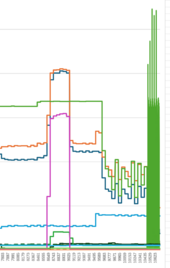In preparation for monitoring my parent's house, I bought an Emporia energy monitor kit with two main CTs and 16 branch CTs. It appears to be a nice little kit and seems to work electrically.
What I thought I bought was the ability to get second by second usage data over a long period of time so I can analyze the energy usage, peak demands, start up loads, etc. I thought the Emporia could do that and the literature sure implied that.
What I have come to find out is that you can only get the last 3 hours of 1 second resolution data. After that it is lost forever. 1 minute resolution lasts a week and then is gone.
This is frustrating. I'll miss key peak demand events and thus can't size an inverter to a critical loads panel or figure out what devices can be on that panel.
How do I solve this?
My query to Emporia got nowhere, they clearly don't care about this.
One idea is to log in every 3 hours and download the CSV data and piece it together to get longer data. This is cumbersome because you have to go the app or website to request the download, then they send you an email link to the data (not as an attachment, alas), and then you have to follow the link to get it. To do this manually is untenable, and to automate it would be a chore and quite complex.
So I am looking for some other solution.
I have found "ESPHome" which looks like an open source firmware load on the Emporia to give you more control:

 github.com
github.com
Will this allow me to collect 1 second resolution data for long periods of time? I couldn't tell from what I found.
If so, can someone point me to a step by step tutorial on how to set this up from flashing the Emporia device firmware to setting up a database/file system to collect the data? It looks like a lot of stuff to configure and all I want is data I can view.
This is easily within my abilities to figure out, I just want to short circuit a learning curve here and get this up and running fast.
Or can I buy something else that will do the job properly?
Mike C.
What I thought I bought was the ability to get second by second usage data over a long period of time so I can analyze the energy usage, peak demands, start up loads, etc. I thought the Emporia could do that and the literature sure implied that.
What I have come to find out is that you can only get the last 3 hours of 1 second resolution data. After that it is lost forever. 1 minute resolution lasts a week and then is gone.
This is frustrating. I'll miss key peak demand events and thus can't size an inverter to a critical loads panel or figure out what devices can be on that panel.
How do I solve this?
My query to Emporia got nowhere, they clearly don't care about this.
One idea is to log in every 3 hours and download the CSV data and piece it together to get longer data. This is cumbersome because you have to go the app or website to request the download, then they send you an email link to the data (not as an attachment, alas), and then you have to follow the link to get it. To do this manually is untenable, and to automate it would be a chore and quite complex.
So I am looking for some other solution.
I have found "ESPHome" which looks like an open source firmware load on the Emporia to give you more control:
GitHub - emporia-vue-local/esphome: Custom component for ESPHome to add support for the Emporia Vue 2 energy monitor
Custom component for ESPHome to add support for the Emporia Vue 2 energy monitor - emporia-vue-local/esphome
Will this allow me to collect 1 second resolution data for long periods of time? I couldn't tell from what I found.
If so, can someone point me to a step by step tutorial on how to set this up from flashing the Emporia device firmware to setting up a database/file system to collect the data? It looks like a lot of stuff to configure and all I want is data I can view.
This is easily within my abilities to figure out, I just want to short circuit a learning curve here and get this up and running fast.
Or can I buy something else that will do the job properly?
Mike C.



